Long White Gypsy uses affiliate links and is a member of the Amazon Services LLC Associates Program. If you make a purchase using one of these links, I may receive a small commission at no extra cost to you. See my Privacy Policy for more information.
So you’ve decided to take on a thru hike of New Zealand’s Te Araroa trail!
This undertaking will see you trek for 3,000 km / 1,860 mi through one of the most beautiful countries on Earth, along beaches, under forest canopies and over mountain passes.
But where on earth do you stay every night??
This post outlines the 4 types of Te Araroa trail accommodation you’ll encounter, how much each costs, what facilities you can expect and everything else you need to know about Te Araroa trail accommodation.
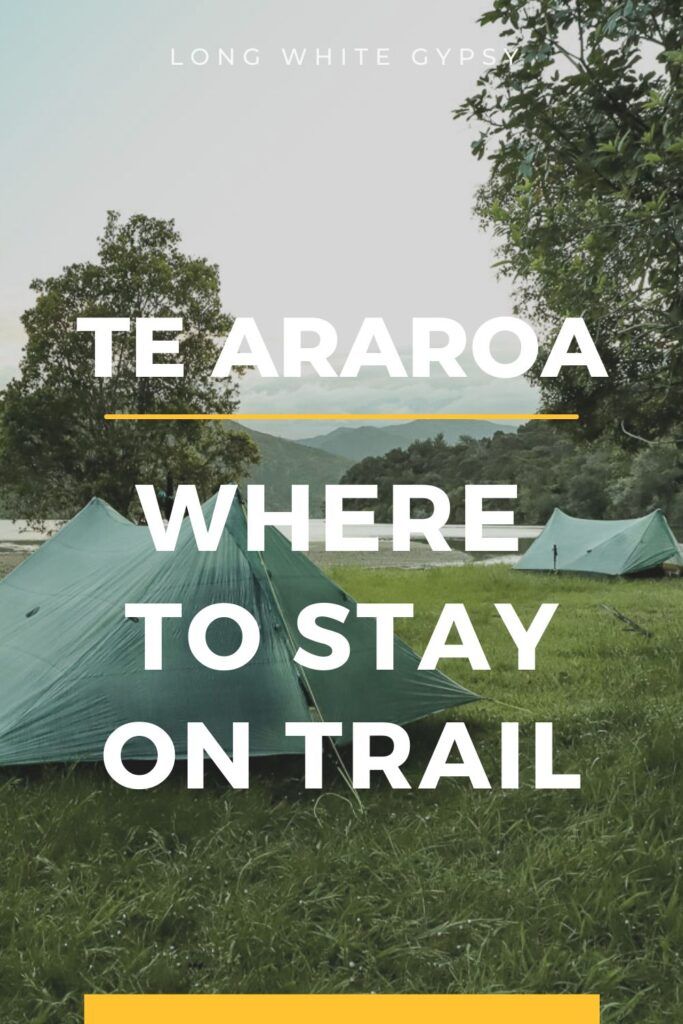
The 4 types of te araroa trail accommodation.
Te Araroa trail accommodation can be grouped into one of four categories:
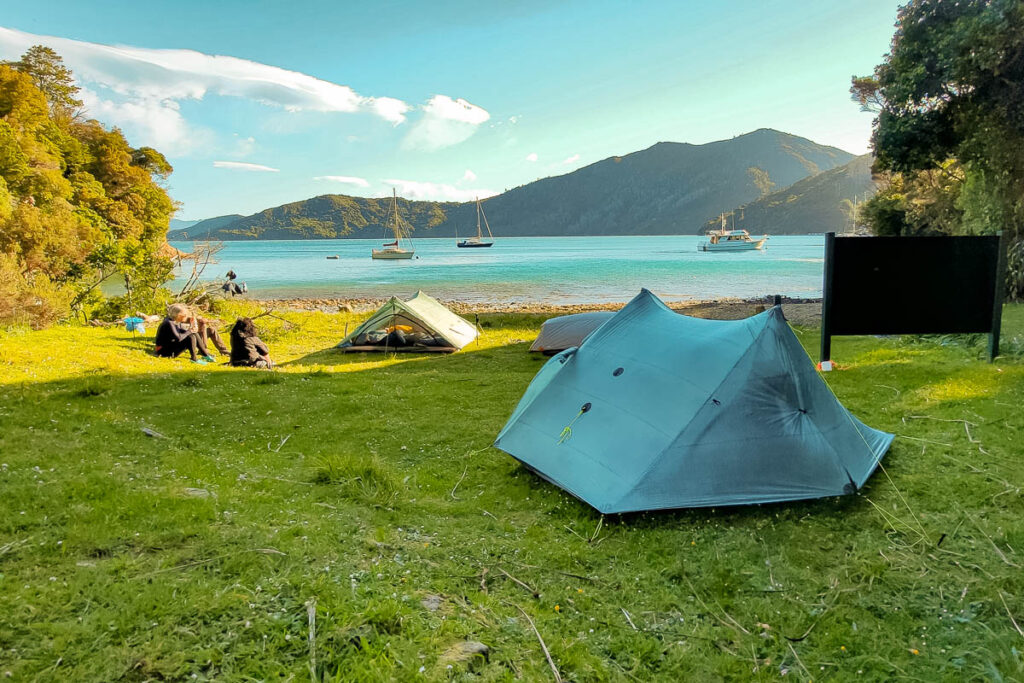
Campsites — Whether these are formal campgrounds, a Department of Conservation campsite or a local’s back yard, this will be your most common type of Te Araroa trail accommodation (just out-ranking huts).

Huts — New Zealand’s network of backcountry huts allows hikers and trampers to explore some of our remotest places in relative safety from the elements. Much of Te Araroa’s South Island section will involve staying at (or next to) huts.
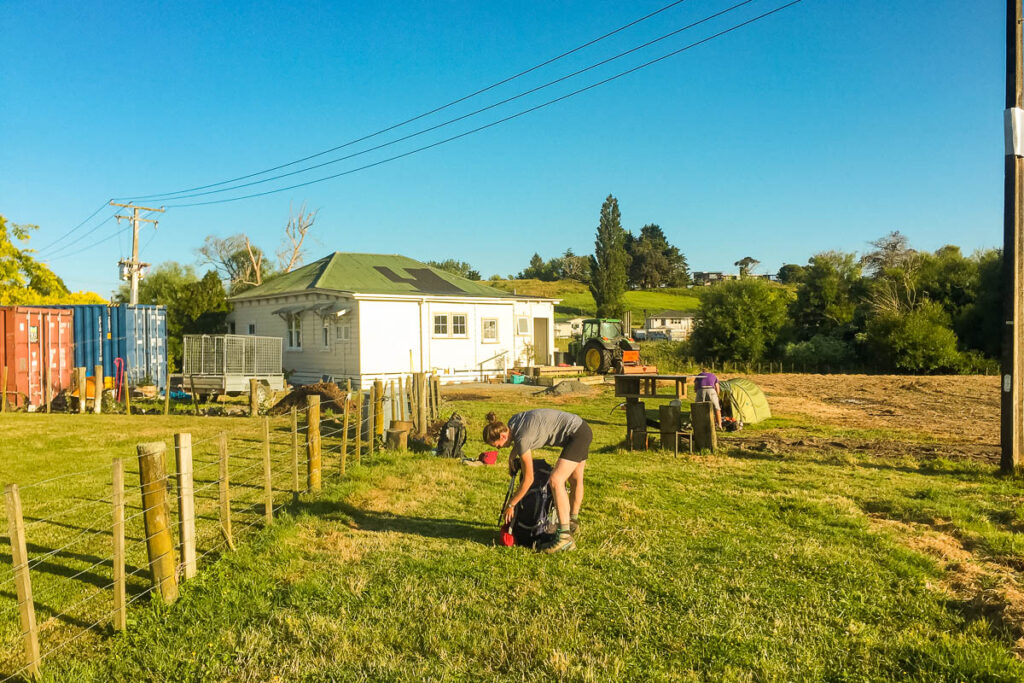
Trail Angels — As with many long distance trails, Te Araroa comes with a growing network of kiwi locals happy to offer up their homes (and bathrooms!) along the way. Most North Island Te Araroa trail accommodation will be with Trail Angels.
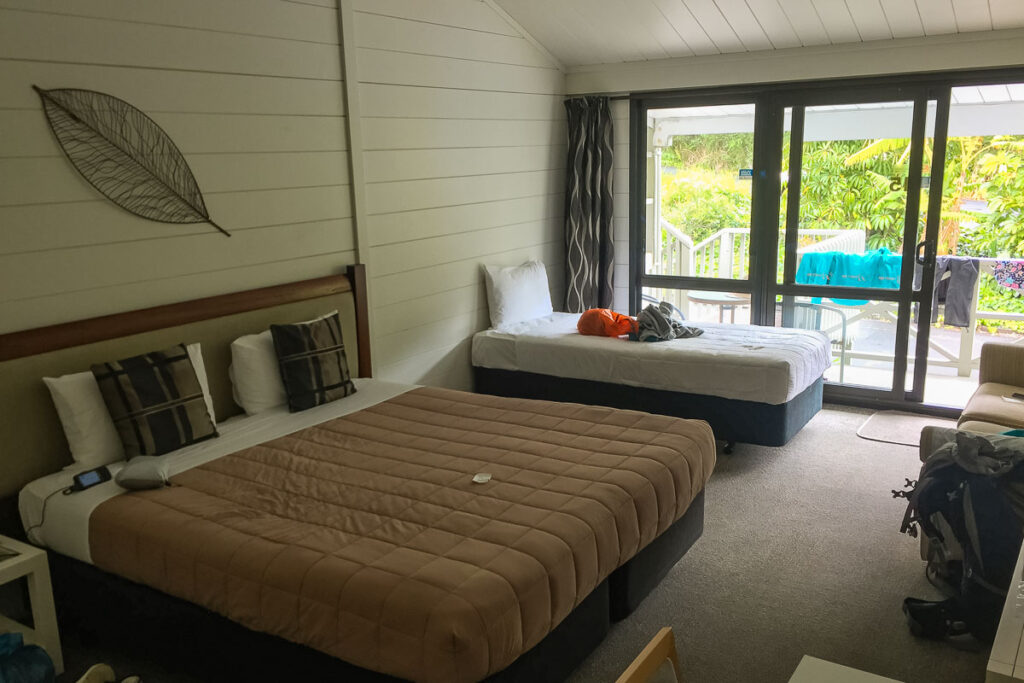
Backpackers / Hostels / Motels — Formal accommodation such as hostels and motels can be found in major cities/towns along the way. These are great places to rest up, recuperate and shower (!) after long wilderness sections.
The remainder of this post goes into detail about what you can expect at each type of Te Araroa trail accommodation, the expected cost and anything else which is important to know.
1 — Te Araroa Campsites
The vast majority of Te Araroa trail accommodation you’ll encounter will be campsites.
There are three main types of campsites you’ll find as you make your way along Te Araroa.
Campgrounds & Holiday Parks
One of the most common types of campsites you’ll find on Te Araroa (but particularly the North Island) are campgrounds or formal holiday parks.
Camping is a big past time in New Zealand, so you’ll find a campground in most places along the route. They are generally a cheap and reliable form of accommodation.
Facilities
You can usually expect to find the following facilities at campgrounds:
- kitchen / cooking facilities (oven, fridge / freezer, stovetop, dishwashing)
- bathrooms (hot showers, flushing toilets, basins, hairdryers)
- laundry (washing machines, dryers)
- internet / wifi connection
- communal indoor areas
- treated water supply
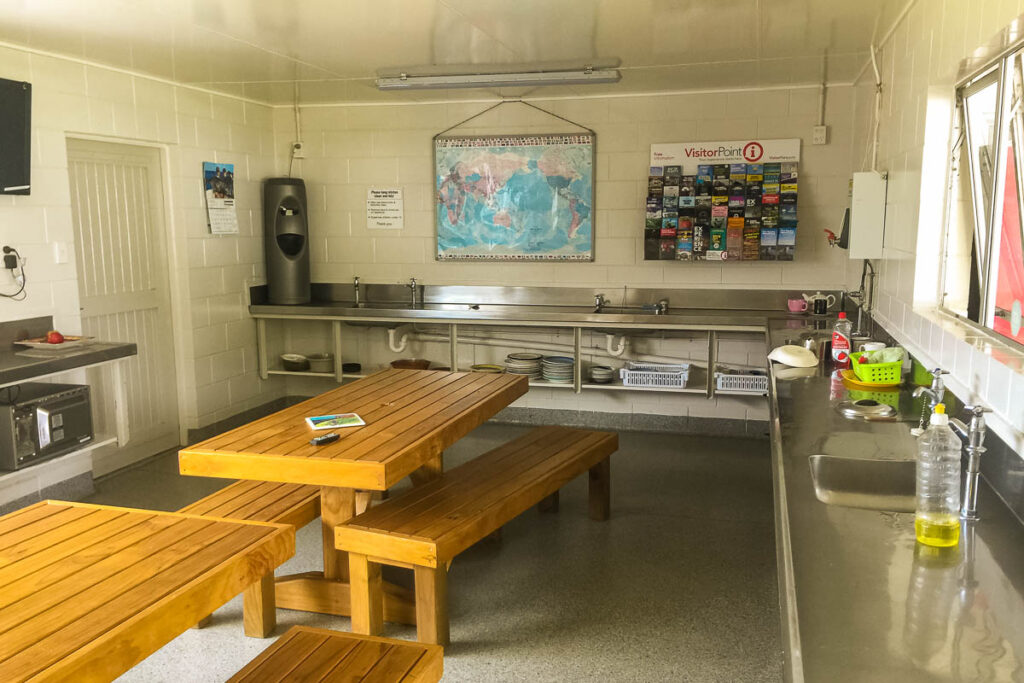
Cost
The cost to stay at campgrounds / holiday parks along the trail will vary widely but as a general rule:
- Unpowered Tent Site – $15 – $35 per night per person.
- Powered Tent Site – $25 – $45 per night per person.
- Basic Cabin (shared facilities) – $80 – $100 per night (up to 2 people).
- Basic Cabin (kitchen only) – $100 – $150 per night (up to 2 people).
- 1 or 2 Bed Unit (own facilities) – $150+ per night (as many as 4 people)
- Hostel Style – $40+ per night (1 person)
* Note that these costs are per person, not per tent or per site. Even though you may be able to fit 2-3 tents per site you will still pay per person.
Additional Costs
- Showers – might be free, or might be coin operated (50c to $2+ for 10 mins)
- Laundry – might be free or might be coin operated ($2 – $6 per wash/dry, hang-dry options usually available)
- Wifi – might be free, but worst case expect to pay $5 – $10 per 500mb (and connections to be slow). Cellphone data more economical.
- Towel Hire – might be complimentary (especially for TA hikers) but could be up to $10.
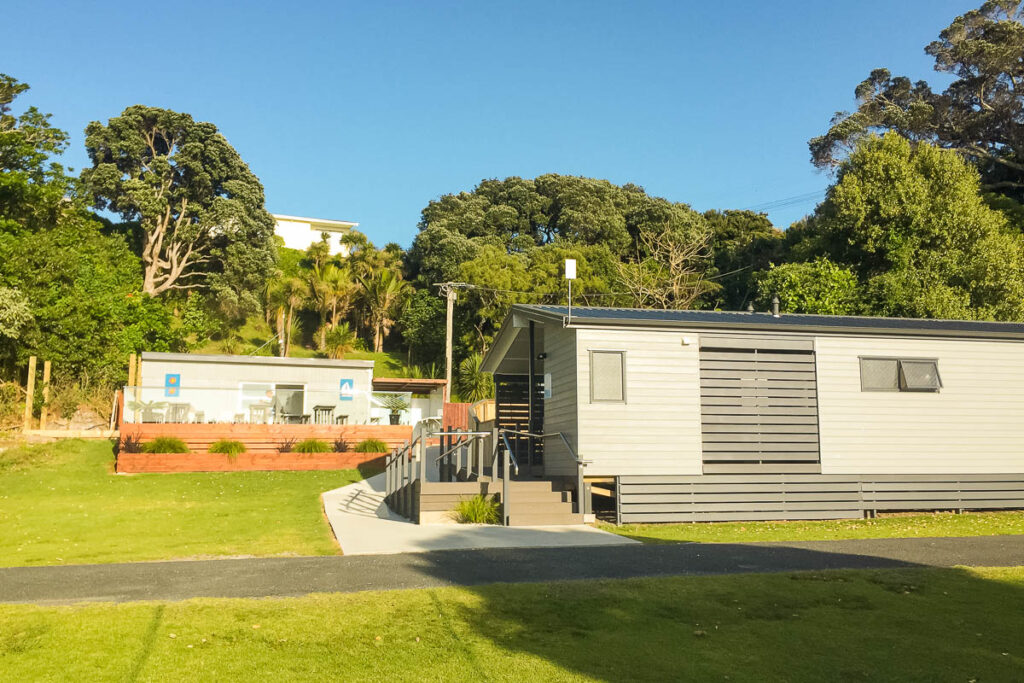
Other Things to Know
Campgrounds and holiday parks can become booked up, especially over the New Zealand summer holiday period (mid November to mid January). It’s worthwhile calling ahead to check availability if you don’t have any other accommodation options.
Trail Angels’ Front/Back Yards
Probably my favourite Te Araroa trail accommodation (especially in the North Island) was with the network of trail angels who open up their homes, gardens & bathrooms to TA hikers.
Staying with Trail Angels is the best way to get to know the locals and enjoy the unique cultural experience that Te Araroa offers, unlike any other long distance trail.
In addition to basic facilities, Trail Angels often provide accommodation in the middle of long sections which don’t have any other accommodation options.

Facilities
Trail Angel accommodation facilities vary widely and depend on each individual, but generally you’ll get:
- a flat place to pitch your tent
- a shower (hot or cold) & flushing toilet
- a treated water supply
Many Trail Angels along the way have built dedicated facilities for TA thru hikers, such as:
- extra bunk rooms and shelters for TA hikers;
- dedicated TA hiker cooking areas & kitchens; and
- dedicated TA hiker bathrooms with hot showers & toilets.
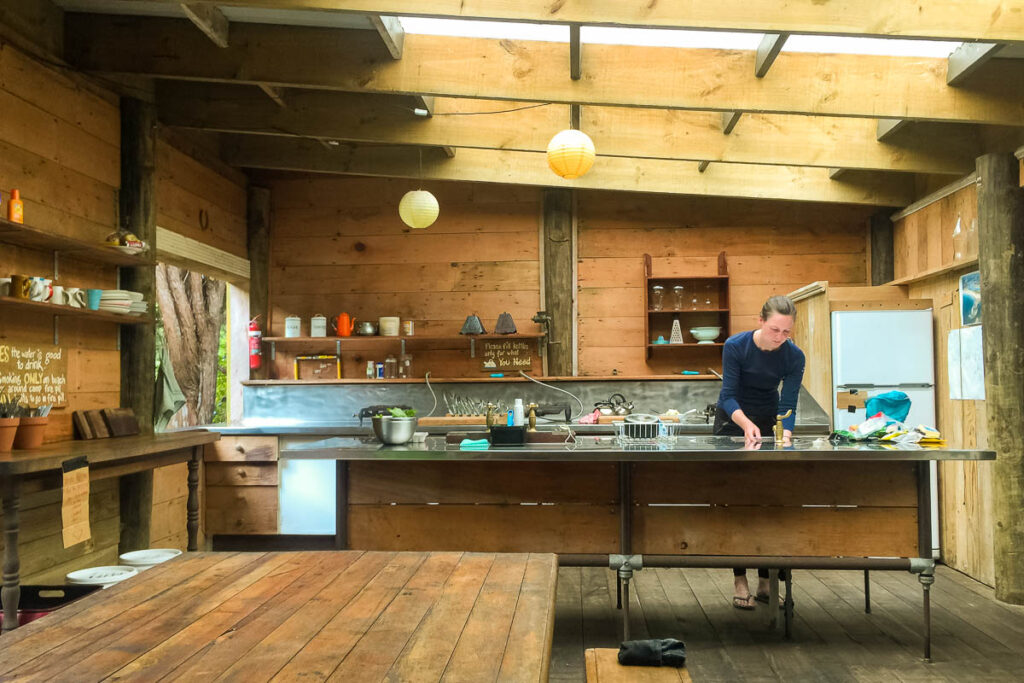
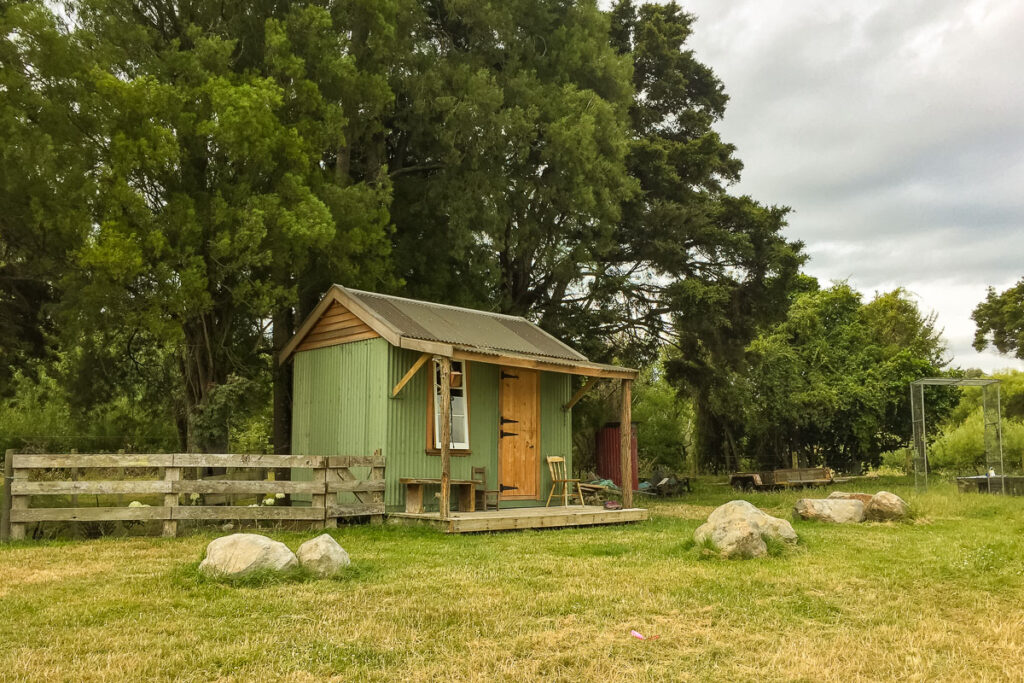

Some trail angels may provide one or more of the following (possibly at extra cost):
- cold drink on arrival
- fresh fruit / vegetables and additional food items
- tea/coffee facilities
- a covered cooking/eating area
- a cooked dinner/breakfast
- shuttles to/from the trail
- hold your resupply box (or help you resupply)
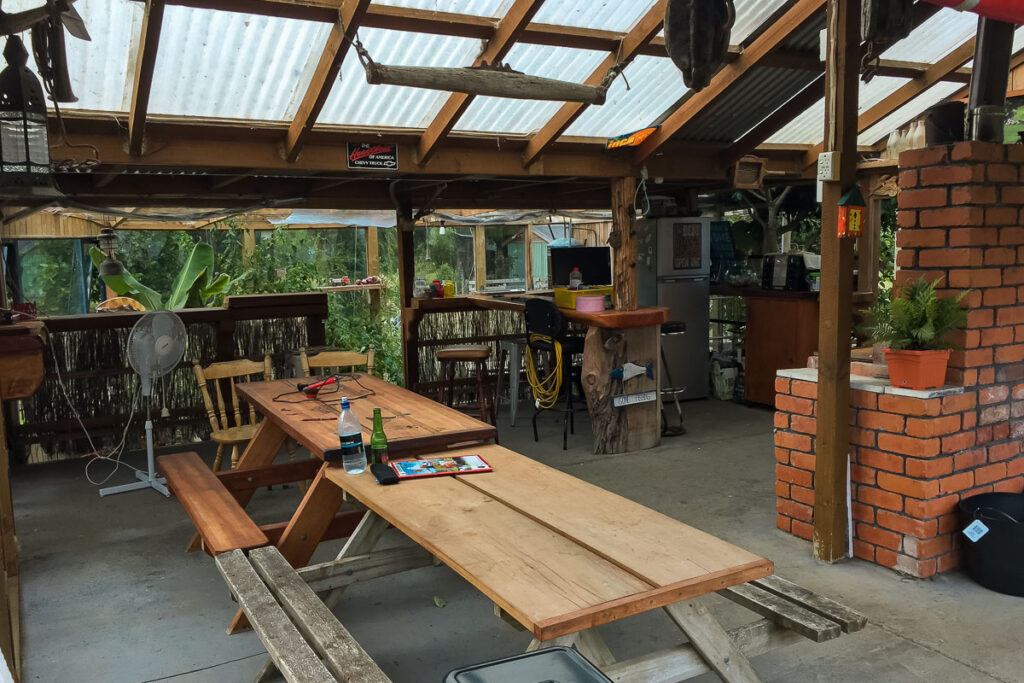
Cost
Te Araroa Trail Angels will either:
- ask for a koha in return for their facilities; or
- charge a fixed price for their campsites.
Traditionally, koha is a “personal expression of your gratitude”. In the TA environment it can take the form of a gift back to the Trail Angel for the service(s) they provide.
The vast majority of TA hikers hand over money because it’s easier (which is perfectly acceptable).
But it’s more respectful to offer your time or services. For example, you could:
- cook a meal for your trail angels and other TA hikers (buy and bring your own food)
- ask your trail angel if they have any work around their property that needs doing (chop firewood, clean etc.)
If you choose to give money as your koha, please make sure you pay a respectful rate for the services you’ve received. My koha donations were generally between $15 – $25 (the same price I expected to pay for a campsite anywhere else on trail).
Fixed prices will be stated in the Te Araroa trail notes (or in comments in The Trail App or FarOut Guides).
As a rough guide, the cost to stay with Trail Angels along the trail is:
- Fixed Price – $15 – $25 per person per night
- Koha – $10 – $30 per person per night (plus extras)

Additional Costs
Many Trail Angels I stayed with offered cold drinks, extra food (fresh veggies etc.) and even full meals. I always made sure to pay a bit extra, for example:
- Supplied Meals – $15 – 20 per meal
- Supplied Drinks – $3 – $5 (ish) per soda, $5 – $8 (ish) per beer.
- Supplied Food Items (e.g. fresh vegetables, canned goods) – paid the supermarket price (or similar) based on what was provided.
Other Things to Know
You’ll need cash to pay for Trail Angel accommodation because they (usually) don’t have the ability to accept debit or credit cards. I carried $50 – $100 in cash (small denominations) with me at all times.
Be respectful and plan ahead. Trail Angels are just regular people! Show them courtesy by letting them know that you’re coming and it’s ok for you to stay.
Don’t overuse resources like hot water or gas. Treat them, their animals, children and property with respect and as if it were your own.

Public Conservation Land (DoC) Campsites
Managed by the Department of Conservation, campsites on public conservation land are available for anyone to use and often located in very scenic locations.
Facilities
Department of Conservation campsites fall into 4 categories:
- Serviced Campsites — have a full range of facilities including flushing toilets, hot showers, kitchen/cooking benches, rubbish collection & tap water* (may need treating). They may have things like barbecues or laundry facilities.
- Scenic / Standard Campsites — have similar but slightly less facilities than serviced campsites. May have flushing, but more likely long drop or composting toilets. Water supply* probably rainwater tank but maybe a stream or lake.
- Basic & Backcountry Campsites — only guaranteed a basic toilet (long drop) and rudimentary water supply* (probably a river, stream or lake).
* water at huts & campsites should be treated in case of contamination.

The majority of DoC campsites on Te Araroa will be basic & backcountry campsites, and you’ll spend a fair proportion of time camping directly outside huts en route.
Cost
- Serviced Campsites — varies per site, but usually around $20 per night.
- Scenic / Standard Campsites — varies per site, but usually around $10 – $15 per night.
- Basic Campsites — varies per site, but usually free.
- Backcountry Campsites — varies per site, but usually $8 – $15 per night.
Other Things to Know
Most basic & backcountry campsites operate on a first come, first served basis. Serviced & standard campsites may need to be booked. Pay attention to the trail notes which will tell you if you need to book ahead.
Find out how much a particular campsite costs, what facilities it has and whether it needs to be booked) by searching for it on the Department of Conservation website.
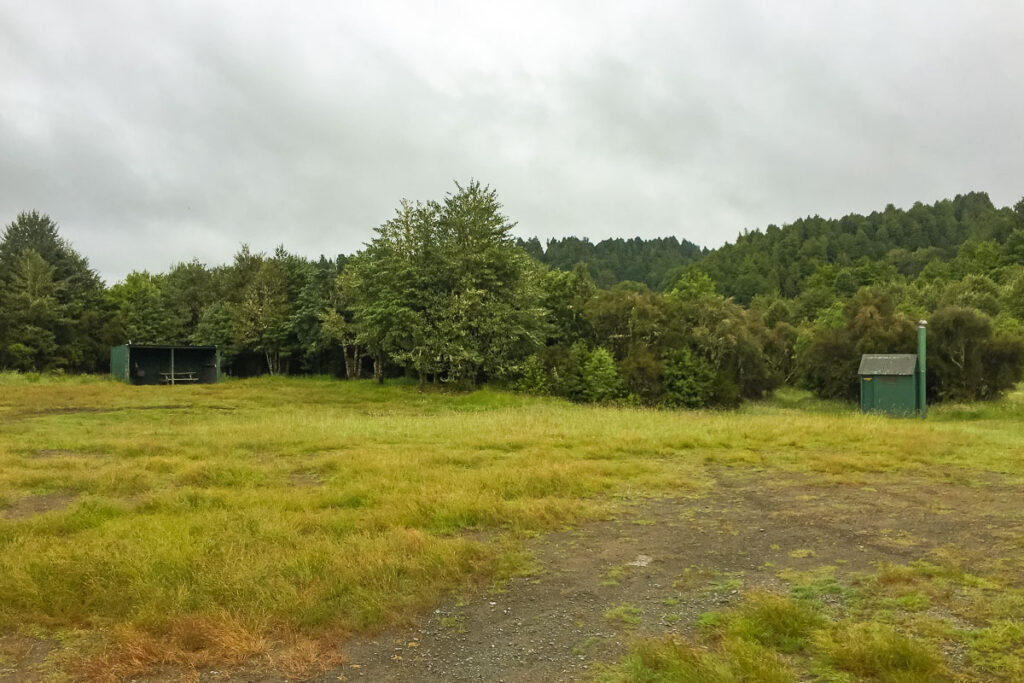
A Note About Freedom/Wild Camping
There’s a lengthy debate online about whether freedom or wild camping is permitted on Te Araroa. So here are the rules.
In New Zealand, the only places you can legally freedom/wild camp are:
- At designated freedom camping / wild camping sites (seems counterintuitive, I know); and
- On public conservation land.
Most of the North Island section of the TA traverses private land. Freedom/wild camping is not permitted on private land (unless with the express permission of the landowner) so don’t try it.
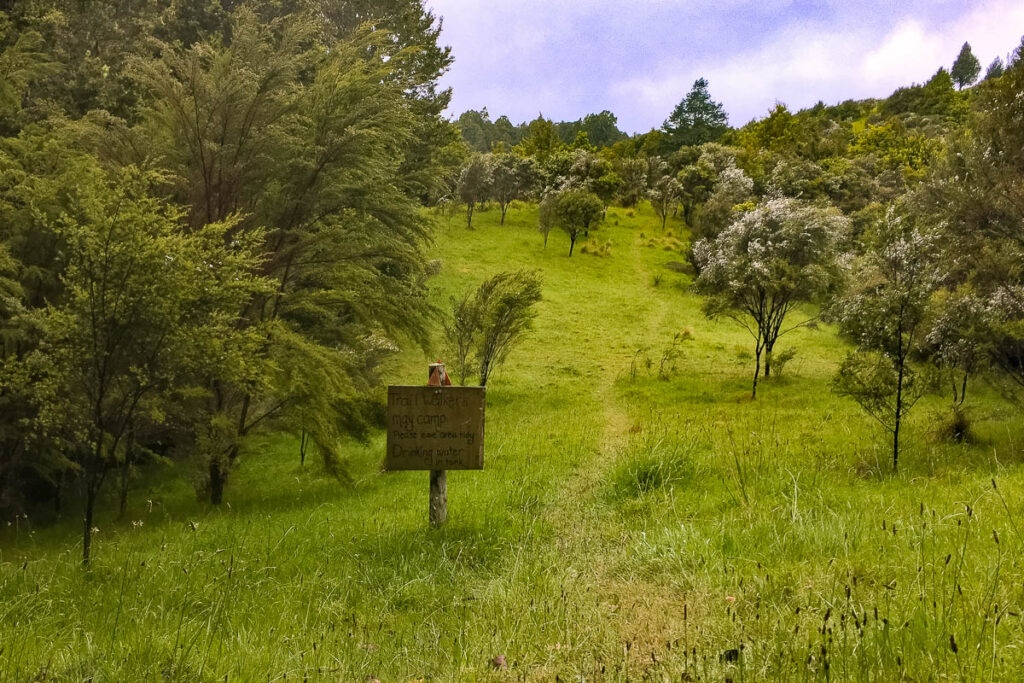
Past TA hikers who have broken these rules have created friction with landowners, sometimes resulting in the closure of entire sections of the trail. This results in lengthy re-routes, often along roads.
If you want to freedom camp to save money and travel on a budget, may I kindly suggest that Te Araroa might not be the trail for you (find out why here).
If you want to freedom camp to experience New Zealand’s famous beauty, don’t worry… there are more than enough opportunities for that at designated campsites along the route. You won’t miss out!
2 — Hostels, Backpackers & Motels
As you reach the end of long stretches, you may prefer to have a proper roof over your head and proper bathroom / kitchen facilities for a night or two (especially on rest days).
This is where hostels, backpackers and motels come are a great type of Te Araroa trail accommodation.
Facilities
Once again there’s no guarantee of what you can expect at hostels & motels, but at the least:
- Bathroom & kitchen facilities — shared at hostels or possibly in-room at motels.
- Proper bed & bedding — may have to use your own sleeping bag/sheets at hostels. Bunk rooms at hostels / backpackers, own room in motels.
- Laundry facilities — probably at an extra cost.
- Wifi internet — possibly at extra cost, or perhaps complimentary at hostels.
- Communal indoor areas — hostel accommodation.

Cost
The cost to stay at hostels / backpackers and motels can vary wildly, depending on location and popularity of the town:
- Hostels / Backpackers – as little as $25 to $60+ per night
- Motels – as little as $80 to $150+ per night
Additional Costs
As with campgrounds and holiday parks, you’ll probably pay extra for:
- Laundry facilities – expect to pay $4 – $10 per load (coin operated), some motels may do laundry for you.
- Wifi internet – expect to pay at most $5 – $10 per 500mb for a (sometimes slow) internet connection.
- Towel hire – could be as little as $2 but as much as $10 per towel.
Other Things to Know
You’ll probably only be able to share a motel room (to split the cost) between up to 4 hikers (depending on the room). Although it’s possible to cram 10 people into a small room, the motel won’t look kindly on it if you try.
Covid has severely affected Te Araroa trail accommodation providers in NZ, with many having closed down due to reduced tourist numbers.

Some places are affected by fruit picking/vineyard harvests (mid Nov to end of Mar). TA season also coincides with the busy school summer holiday and Christmas / New Year period. More locals and international visitors travel around NZ between early Dec and late Jan.
If you’re planning to stay in commercial accommodation in any of these places, call ahead to check availability & make a booking before you arrive:
- Kerikeri (fruit picking season coincides with TA season)
- Paihia (popular tourist destination)
- Nelson (fruit picking & vineyard season, and popular tourist destination)
- St Arnaud (popular tourist & summer hiking destination)
- Tekapo (popular tourist destination)
- Wanaka (popular tourist destination)
- Queenstown (popular tourist destination)
3 — Backcountry Huts
Although you’ll only encounter about 13 in the North Island, as you traverse the South Island your main form of Te Araroa trail accommodation will be backcountry huts.
These wilderness refuges provide much-needed shelter from bad weather and excellent rest points, usually spaced 4 – 6 hours apart.
Staying in New Zealand backcountry huts is a rite of passage for any Te Araroa hiker, and I encourage you to stay in as many as possible just for the experience.

There are five categories of huts in NZ:
- Great Walks Huts — Huts on our most popular tracks – the Great Walks.
- Serviced Huts — Our most popular backcountry huts.
- Standard Huts — Remote huts with reduced facilities.
- Basic Huts / Bivvies — Very basic, okay for shelter and not much more.
- Club / Private Huts — Available to members of a specific club or organisation (e.g. NZ Alpine Club, regional tramping clubs) but sometimes available to public.
Facilities
On Te Araroa you’ll mostly be staying in basic & standard huts which should include:
- Bunks & mattresses — Often 6 bunks at most. Plastic covered foam mattresses.
- Water supply — Usually a (small) rainwater tank to an indoor or outdoor sink, or a nearby river or stream. Will need to be treated in case of contamination.
- Cooking bench — A stainless steel bench is common but may not be present if limited space.
- Toilets — Very basic long drop, vault or composting toilet.
- Heating — Huts probably have some kind of wood burner (some may have coal) but usually only if below the bushline.
Just to be clear, you won’t find any of the following at backcountry huts:
- Rubbish Bins — Huts are too remove to be serviced by rubbish collection. Pack all your rubbish out with you.
- Toilet Paper — Toilets, yes. Toilet paper, no. Don’t get caught out.
- Cooking Facilities — Unless you want to cook on the wood burner (which isn’t always possible) you’ll have to bring your own stove & fuel. You also need your own pots, pans, dishes & utensils.
- Sheets / Linens / Pillows — Bring your sleeping bag and an inflatable pillow if you need one.
- Lighting — Most basic & standard huts don’t have lighting, so bring a headtorch.

Cost
The nightly rate for the types of huts you’ll encounter on Te Araroa is:
- Serviced Huts – $15 per adult per night.
- Standard Huts – $5 per adult per night.
- Basic Huts – Free.
I recommend all Te Araroa thru hikers purchase a Backcountry Hut Pass. For a one-time fee of $108 (for 6 months) you can stay at as many backcountry huts as you desire, making it a very economical option for TA Hikers.
You can buy a pass online (recommended) or at selected information centres and Department of Conservation offices (the most common for Te Araroa walkers is at the Auckland iSite).
Some huts on Te Araroa are excluded from the Backcountry Hut Pass. You’ll need to purchase tickets for these separately if you want to use them.

Bookings
Most huts on the TA route don’t require bookings. However, you will pass by some huts that need to be booked in advance.
The best way to check if you need to book a hut before you stay is by searching for the hut on the Department of Conservation website. If it requires a booking, there’ll be a yellow “Book Online” button on the individual hut page.
Other Things to Know
Although I’ve recommended you purchase a hut pass, you probably won’t need it until you reach the Tararua Ranges (SOBO) so you could hold off purchasing your pass until you reach Palmerston North.
You can camp outside any Basic or Standard hut in New Zealand for free. If you’re camping outside a Serviced hut there is a fee of $5.
The Golden Rule: If you’re staying in a hut, please make sure you pay for it and follow the hut etiquette principles.
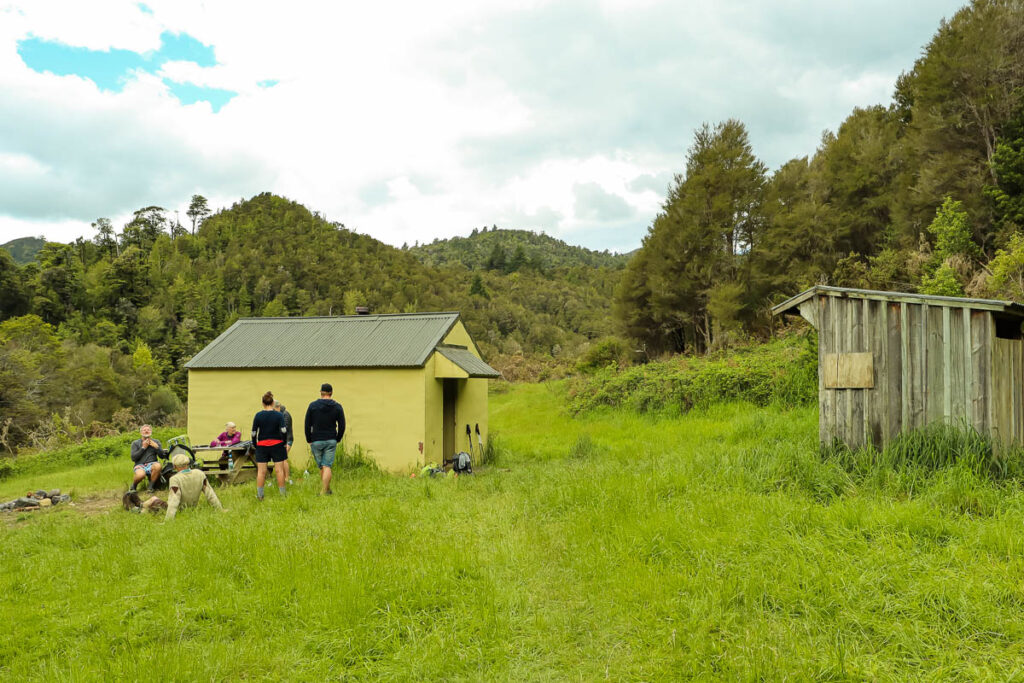
Final Thoughts
I’ve done my best in this post to outline the main types of Te Araroa trail accommodation you’re likely to encounter on your thru or section hike.
Whatever Te Araroa trail accommodation you decide to stay in along the way, always be respectful (to your hosts and other TA hikers), clean up after yourself and leave the place looking better than you found it!
For more information about hiking the Te Araroa Trail, visit my Te Araroa page.
